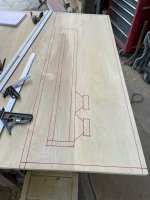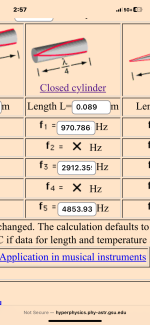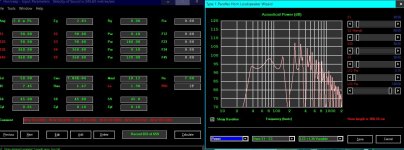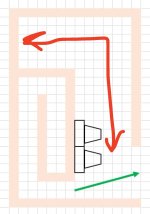BL^2/re is like 96?
I wonder if motor constant is more relative than bl alone. The measurement is a little closer @ 9.87 vs 13.2.
I was just using loudspeaker database. Different calculation I guess.BL^2/re is like 96?
Which btw, this is the PRV
Motor constant Bl/√RE 9.89
Basically the same as the empero
bl is nearly half on the empero because re is half. Less vc windings makes lower motorforce. If impedance were the same as b&c bl would be the same.
I have never heard a paraflex type box. The SPL charts look good, but come at a heavy price of size and weight. It seems however, everyone that has heard one says the same thing “punchy!”
My question is: How do you sim or measure the punchy sound? Is it just the SPL bump at chest resonance, or is it more than that?
It would be interesting to take a ROAR 15 and a TH/manifold of the same external volume and eq them to look identical on the SPL chart and see if the ROAR still feels more punchy.
I have also heard people say that paraflex has a cardioid effect. I have however never seen any measurements baking up this statement. It would be fun to measure one from different angles to bust or confirm this myth.
My question is: How do you sim or measure the punchy sound? Is it just the SPL bump at chest resonance, or is it more than that?
It would be interesting to take a ROAR 15 and a TH/manifold of the same external volume and eq them to look identical on the SPL chart and see if the ROAR still feels more punchy.
I have also heard people say that paraflex has a cardioid effect. I have however never seen any measurements baking up this statement. It would be fun to measure one from different angles to bust or confirm this myth.
Check this video.I have also heard people say that paraflex has a cardioid effect. I have however never seen any measurements baking up this statement. It would be fun to measure one from different angles to bust or confirm this myth.
screenshot shows the front vs rear spl.
So I guess I have 2 questions. How much motorforce is necessary. And how do you predict qtc or transient response from high order qw enclosures like this?
I do have a pair of Dayton 12lf drivers on hand. They seem to match criteria better than empero 15c. They are 8 ohm though so naturally I would have to build 4 lol. But that response graph and price is just so tempting. Opinions welcome!
What kind of gain should be expected when stacking? 6db? 2 roar12s should have better output that 1 15 correct?
Doubling cabs = +3dB
Doubling power = +3dB
Doing both = +6dB
-----------
Last question ...
Overall SPL yes
Lowest F3 No
Doubling power = +3dB
Doing both = +6dB
-----------
Last question ...
Overall SPL yes
Lowest F3 No
Last edited:
A Paraflex is more like below.
The low tune port firing directly into the high tune port makes the BP6S act like a BP6P.

The low tune port firing directly into the high tune port makes the BP6S act like a BP6P.
Good to see some actual measurements!screenshot shows the front vs rear spl.
The single SPL vs rear differences are a bit high due to more upper band reduction than low end.
The cabinets proximity to the buildings (and truck) are different for each cabinet, which affects their response.
None of the unused cabinets were shorted out during the tests, which affects each response, the adjacent cabinets act as passive radiators, creating dips and peaks in the response.
The rear wall constructive and destructive reflections are more apparent with the mic position moved from front to rear.
Some of those problems could have been reduced by testing each cabinet one at a time in the same position, and rotating the cabinet rather than moving the mic position.
Interesting to see the upper cancellation dip (circled) is considerably reduced in the rear measurements, a relative increase in level:
The increased front to rear SPL ratio of tapped horns (TH) over bass reflex (BR) or front loaded horns (FLH) does increase their direct to reflected ratio in enclosed spaces, which may subjectively increase "punch".My question is: How do you sim or measure the punchy sound? Is it just the SPL bump at chest resonance, or is it more than that?
An increased decay time of the upper resonance may also make the upper range "feel" louder than it measures.
Here is a comparison of directivity between TH, FLH and BR cabinets:
There have been various claims regarding the directivity of tapped horns, but since I had not seen any tests done comparing them to bass reflex (BR) or standard front loaded horns (FLH), I did some testing myself.
As suspected, TH in themselves have little more directivity than other types of cabinets below around 60 Hz, but do become more narrow in dispersion above.
The LF directivity others have noted when TH are used in multiples comes primarily from the increased frontal area acting as a plane, transitioning from 1/2 space to 1/4 space. This same effect happens to some extent with any...
As suspected, TH in themselves have little more directivity than other types of cabinets below around 60 Hz, but do become more narrow in dispersion above.
The LF directivity others have noted when TH are used in multiples comes primarily from the increased frontal area acting as a plane, transitioning from 1/2 space to 1/4 space. This same effect happens to some extent with any...
- weltersys
- Replies: 24
- Forum: Subwoofers
Jbell's SS15 tests had a similar upper reduction, and around -6dB reduction at 50 and 75Hz, more low end reduction than my TH test.
The proximity of buildings, even though considerably more distant than in the video in post 284 still had a considerable affect on my measurements, but the TH did have considerably more upper directivity than the FLH and BR.
Cardioid subwoofer arrays use a rear-facing subwoofer with it's polarity reversed and a delay added to it's signal equal to the 1/4 wave acoustic path length difference.I have also heard people say that paraflex has a cardioid effect.
I suspect the two sources of sound (front horn path/inverted polarity longer rear horn path) in a TH is also responsible for some of their cardioid pattern.
Art
Thank goodness you described the 970 hz reflection from the closed end 😝
You can describe anything you want using the ‘ph’ section. (It might require you to actually built it to understand that however)
Attachments
Stop please….A Paraflex is more like below.
The low tune port firing directly into the high tune port makes the BP6S act like a BP6P.
View attachment 1371020
Attachments
You get that 120cm(72hz) reflection in that ‘paraflex’ or offset resonator qw pipe thingy
Attachments
Last edited:
Thank goodness you described the 970 hz reflection from the closed end 😝
You can describe anything you want using the ‘ph’ section. (It might require you to actually built it to understand that however)
Where the PH functions added to HR for Paraflex enclosures?
- Home
- Loudspeakers
- Subwoofers
- ROAR15






